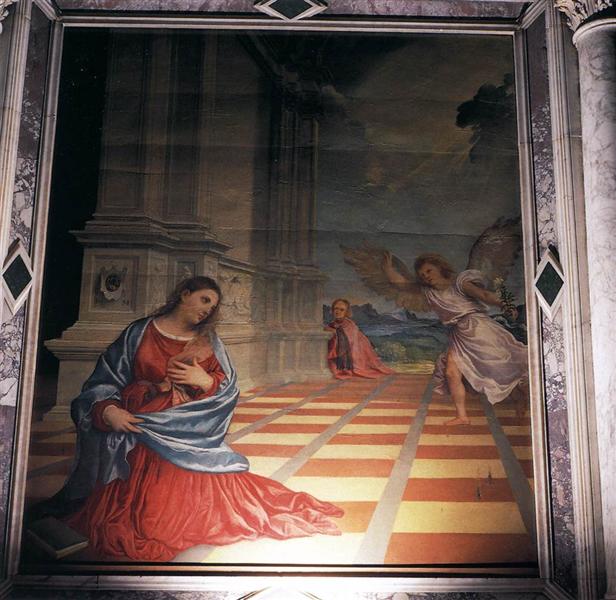Description
Titian's painting "The Annunciation", created in 1519, stands as a sublime testimony to the mastery of this Venetian artist, known for his ability to infuse colour and emotion into his works. In this depiction, Titian addresses one of the most recurrent themes in Christian art: the annunciation of the Archangel Gabriel to the Virgin Mary, a moment of great spiritual significance that has been the subject of countless interpretations throughout the history of art.
The composition of the work flows with a narrative serenity that is characteristic of the Renaissance. The figure of the Virgin is placed on the left side, dressed in a blue cloak, a color that is overflowing with symbolism, representing both purity and divinity. The disposition of the figure of Mary is serene and receptive, capturing a moment full of reverence and expectation. The angle of her head, which leans slightly towards the archangel, suggests an openness to what is about to happen.
The Archangel Gabriel, on the right, is depicted with a majesty that is expressed by his rich, yet light clothing, highlighting the heavenly nature of his being. His posture, with one arm extended towards Mary, and his intense gaze, lend a vivid dynamism to the scene. The archangel's gesture conveys both the authority of his message and the sweetness of the announcement of the Savior's arrival.
Titian’s attention to the use of colour is evident in this work. The contrast between the ivory skin of the figures and the vivid tones of the clothing creates a visual depth that is captivating. The manipulation of light also plays a crucial role; the light source seems to emanate directly from the sky, illuminating the characters and accentuating the sacred halo that surrounds the scene. This luminous guide allows the scene to be filled with an ethereal aura, bringing the narrative to life through points of light and shadow.
Compositionally, the scene is carefully balanced. Titian uses diagonal lines that lead the viewer's gaze naturally from Gabriel's feet to Mary's face and back again, creating a dialogue between the two figures that is both intimate and divine. This use of composition, along with the inclusion of the architectural background that evokes freshness and a sense of place, adds a layer of depth and context that enriches the viewer's visual experience.
The historical context in which Titian painted The Annunciation is relevant. 16th-century Venice was a melting pot of cultural influences, and Titian, as a master of colour, was able to synthesize these influences, developing a style that evoked both Venetian tradition and the innovations of the Renaissance. This approach would allow him not only to follow in the footsteps of his predecessors, such as Giovanni Bellini, but also to set new standards in the work to come, marking a shift towards a more emotional and sensorial style.
In conclusion, Titian's "The Annunciation" is not just a depiction of a religious event, but a work that encapsulates the artist's technical mastery and keen emotional understanding. Every element in the painting, from the choice of color to the configuration of the figures, speaks of a vision that transcends space and time, allowing the viewer to participate in the mystery of faith through beauty. This work remains a fundamental reference for understanding the evolution of Renaissance art and the gap towards the Baroque, sustaining Titian as one of the great masters of Western painting.
KUADROS ©, a famous painting on your wall.
Hand-made oil painting reproductions, with the quality of professional artists and the distinctive seal of KUADROS ©.
Painting reproduction service with satisfaction guarantee. If you are not completely satisfied with the replica of your painting, we will refund 100% of your money.

